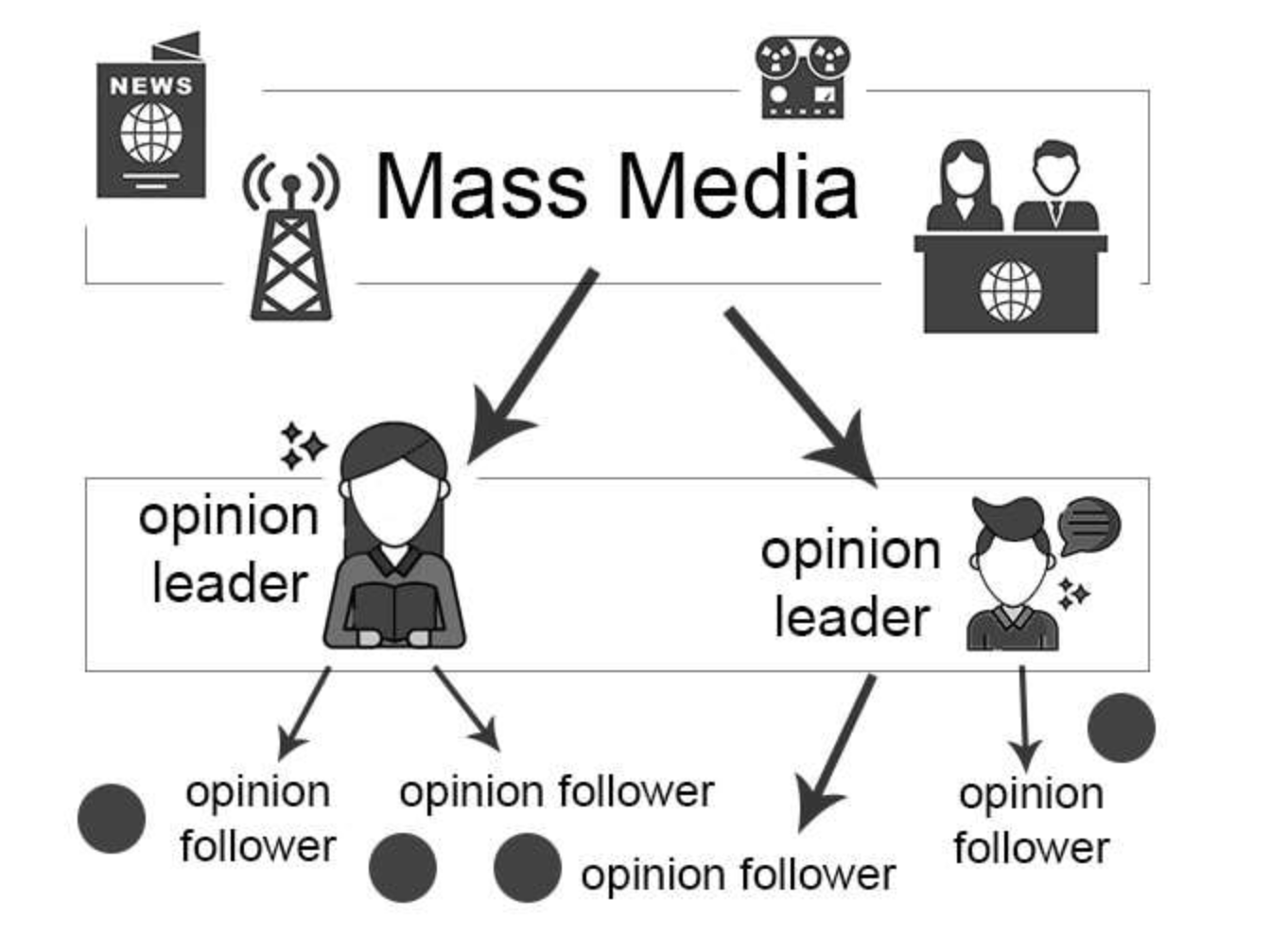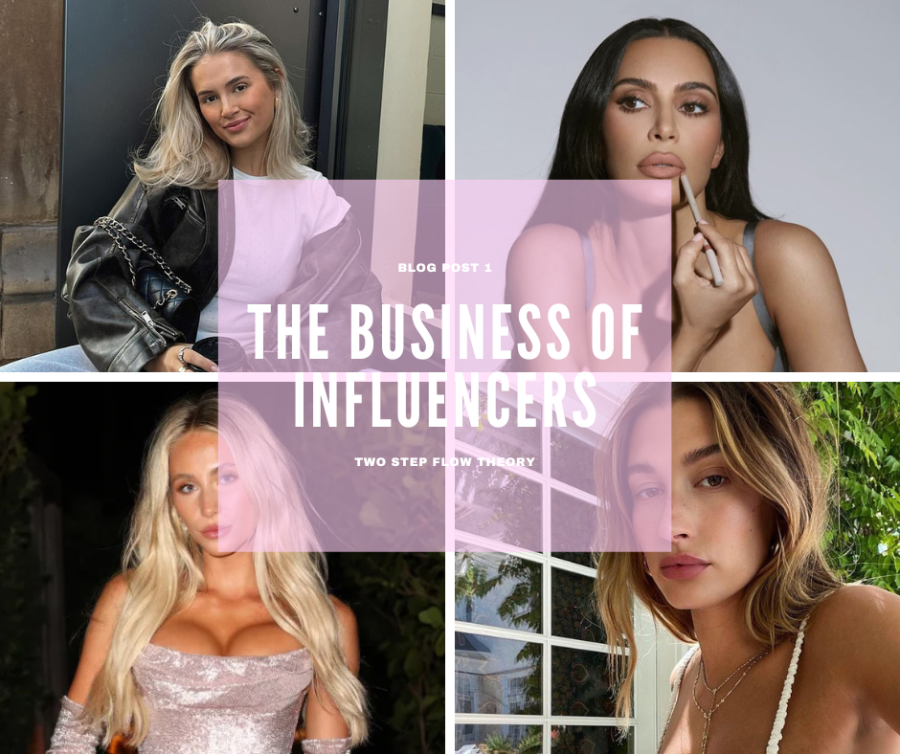
A study conducted in the 1940s by Paul Lazarsfeld, Hazel Gaudet, and Bernard Berelson found that during political elections only five percent of the public were influenced directly by the political campaigns on their vote. The other ninety five made their choice based on information they would hear from their family members or friends.
This led to the introduction of the Two Step Flow Theory which suggests that the flow of communication between the media and their desired audience is not direct. Media first reaches ‘opinion leaders’ who then relay their own interpretations of the information they received to audiences, who are ‘opinion followers’ (Medium, 2023).
Audiences are more likely to trust information that comes from an opinion leader due to the pre-existing relationship and trust between them.
Although originally this theory takes place in a political context, it can be applied to how brands use social media influencers (opinion leaders) in their marketing to reach consumers.
84% of Gen Z in the UK have reported following influencers on social media in 2023 (Statista, 2023). Influencers work on building relationships with their online audience through regular engagement, be it by replying to comments or by posting content that presents their most authentic self. If an influencer talks about a product on their social channels, it exposes the brand to consumers that potentially wouldn’t be reached through direct brand advertising. An admiration for the influencer or long build-up trust would result in positive associations with the brand, and potentially consumers purchasing the product.
With the potential outreach that comes with influencers, it is no surprise that more than a quarter of brands and agencies spent over 40% of their marketing budgets on influencer marketing (Statista, 2024).
However, this theory overlooks how modern technologies have evolved since the 1940s. Due to social media algorithms, your feed will be curated based on what you have watched before, or something that closely aligns with interests you previously displayed on that platform. This results in ‘echo-chambers’ where the same information gets relayed on to you over and over, with little exposure to the opposing view (Dubois, E., Minaeian, S., Paquet-Labelle, A., & Beaudry, S., 2020).
There is also the matter of audiences questioning the authenticity of the influencer’s claims due to understanding the potential financial interests for both the brand promoted and the influencer. A conducted poll shows that 73 percent of users view sponsored content on social media as less authentic (KayteFerris, 2021). Influencers can make false claims about products to stay on brand PR lists or fulfil a contract they signed for money; therefore, they no longer have an impartial opinion that audiences can fully trust.
Due to large levels of misinformation available online, audiences have now become more active content consumers, looking for back up claims and various sources before making their decisions. The original theory places most consumers into a passive role and fails to acknowledge personal autonomy and the ability to reject the opinion leader’s view.
References
Beiro, L. (2023) Let me see you one, two-step (flow of communication theory), Medium. Available at: https://medium.com/@lexiebeiro/let-me-see-you-one-two-step-flow-of-communication-theory-17cb4c2b5357 (Accessed: 21 October 2024).
Capterra. (2023). Share of consumers who followed influencers in the United Kingdom (UK) as of April 2023, by generational cohort. Statista. Statista Inc.. Accessed: October 21, 2024. https://www.statista.com/statistics/1440959/share-consumers-follow-influencers-uk/
Dubois, E., Minaeian, S., Paquet-Labelle, A., & Beaudry, S. (2020). Who to Trust on Social Media: How Opinion Leaders and Seekers Avoid Disinformation and Echo Chambers. Social Media + Society, 6(2). https://doi.org/10.1177/2056305120913993
Ferris, K. (2021) Why people engage less with sponsored content, and what we can do about it, Kayte Ferris. Available at: https://kayteferris.com/blog/2018/06/27/why-people-engage-less-with-sponsored-content-and-what-we-can-do-about-it (Accessed: 21 October 2024).
Influencer Marketing Hub. (2024). Share of marketing budgets spent on influencer marketing worldwide as of February 2024. Statista. Statista Inc.. Accessed: October 21, 2024. https://www.statista.com/statistics/268641/share-of-marketing-budgets-spent-on-digital-worldwide/
Image References
Rosenblatt, K. (2024) Alix Earle apologizes for past racist comment on social media, NBCNews.com. Available at: https://www.nbcnews.com/pop-culture/pop-culture-news/alix-earle-apologizes-racist-comment-social-media-rcna168411 (Accessed: 23 October 2024).
Sansome, J. (2024) Molly-Mae Hague shows off new look as she ditches UK after ‘Home Life’ admission, Manchester Evening News. Available at: https://www.manchestereveningnews.co.uk/news/showbiz-news/molly-mae-hague-shows-new-30147351 (Accessed: 23 October 2024).
Two step flow theory of communication: Definition and analysis (2022) Media Studies. Available at: https://media-studies.com/two-step-flow/ (Accessed: 23 October 2024).
UK, FashionNetwork. com (2024) Kim Kardashian announces Skkn by Kim Makeup, FashionNetwork.com. Available at: https://uk.fashionnetwork.com/news/Kim-kardashian-announces-skkn-by-kim-makeup,1595272.html (Accessed: 23 October 2024).
Vischer, A. (2022) Hailey Bieber uses this £26 concealer and a £32 tinted SPF to get her signature glow, Grazia. Available at: https://graziadaily.co.uk/beauty-hair/makeup/hailey-bieber-concealer-tinted-spf/ (Accessed: 23 October 2024).


Great insight on influencers and their marketing impact!
Great analysis! You clearly explained the two-step flow theory and its application to modern influencer marketing in an engaging way!
I’m curious, what’s your personal take on influencers as a marketing tool—do you trust their recommendations, and do you ever buy things based on their suggestions? Many people seem to perceive a lack of objectivity in such promotions, but marketing relies on emphasizing positive product features, regardless of the medium. After all, we rarely see ads—even traditional ones—that highlight a product’s flaws. In this sense, do you think that every type of marketing has a certain level of subjectivity?
I really enjoyed your article! It’s fascinating and interesting to see how a theory from the 1940s can still be useful today, especially with the example of influencers. It’s true that we often trust someone we “know” more than a brand. I also think that the bond of trust that influencers create with their subscribers is hyper-powerful, thanks to the relationship they’ve had to create with their community.
But as you said, with algorithms, we quickly find ourselves in a precise category without really paying attention. And with paid collaborations, there’s always that doubt about the sincerity of what they say, which complicates that famous “trust” we place in them. Today, I have the impression that our generation is also tending to be more informed, to cross-check sources, which shows that we’re no longer just passive “followers” as in the original theory.
You did a good job!
Your own subjective experience with opinion leader influence gives this theoretical argument a human face. Refreshingly, this is a case of making the theory far more relevant to real life. Having said that, my question will be about communities who might get left out. Might there be groups or demographics out there whose influencers’ voices get consistently muffled by algorithms? Studying these gaps would expose us to how-or even if-the two-step flow theory applies across the board to today’s increasingly atomized digital space.